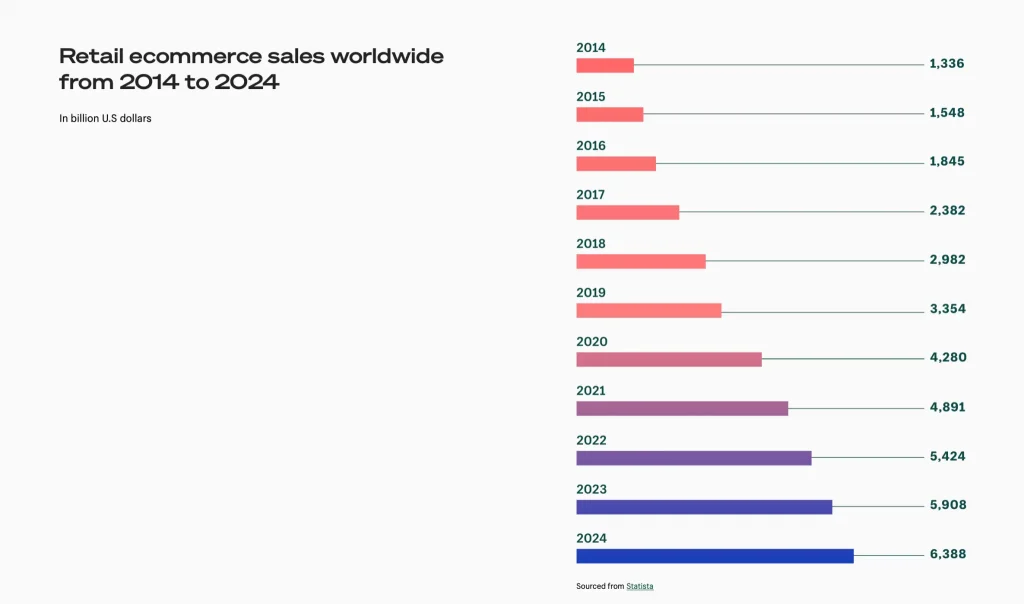There have never been as many opportunities in the ecommerce space as there are at the moment, nor has there been so little competition. However, the plummeting return on ad spend is pushing brands to prioritise customer lifetime value and promote brand loyalty.
Trust is the main currency of the future of ecommerce. Brands must be transparent, authentic, and readily available to their customers, especially where online consumers spend most of their time: on social media. Social commerce is at the centre of online shopping for tomorrow’s consumers, with brands investing in video and live shopping.
Direct-to-consumer (DTC) companies are also investing in online communities to humanise their brands, increase customer retention, and overcome skyrocketing advertising costs.
Thriving in this new ecommerce landscape will require unique insight and action. Shopify conducted extensive research with hundreds of DTC brands and thousands of consumers to identify the most important trends for 2022, as well as the strategies and products your business needs to stay ahead of the competition, from which these are the conclusions.
Fewer barriers to entry mean more ecommerce growth
Advancements in technology and the growth of available marketplaces have made it easier than ever to buy and sell online. The ecommerce market is expected to grow by almost $11 trillion between 2021 and 2025. As businesses came online during the COVID-19 pandemic, the global trend toward digitisation surged ahead at lightning speed. Even as regions begin to reopen, ecommerce sales are still climbing. Global ecommerce sales are expected to reach $5 trillion in 2022, and $6 trillion by 2024.
Merchants continue to follow consumer demand online, flocking to ecommerce in record numbers. Online stores are popping up daily, with an estimated 12–24 million ecommerce sites across the globe. This means more brands competing for customers. As a result, digital advertising is more costly and less lucrative than ever before.
Merchants are spending more and gaining less
Competition is the biggest obstacle to achieving growth in 2022, according to the 350 global commerce decision-makers surveyed for their report. With privacy laws that limit marketers’ ability to target ads and consumers who are better at blocking ad interruptions, it’s becoming tougher to get a decent return on advertising spend. The cost per click for paid search ads increased by 15% between the second and third quarters of 2021 alone.
“Our July report showed a 15–20% drop in the advertising reach of Instagram in Europe,” says Kepios founder and CEO of Datareportal, Simon Kemp. “That’s huge. Tens of millions of impressions disappeared because of certain kinds of laws and changes in Apple’s policies.”
Despite the changing digital ad landscape, 41% of brands* plan to increase investment in paid and organic search. Many hope that advances in personalisation will make their advertising dollars more effective by targeting consumers who are ready to purchase. But there are at least three problems with this approach:
- Audience segmentation is not viable. Harvard Business Review tested the accuracy of the digital profiles data brokers sell, and the results were dismal. The age tier was only correct 23% of the time, and gender was properly identified in well below half of cases.
- As advertising platforms get more competitive, brands that haven’t developed familiarity and trust with consumers will become more entrenched in a direct-marketing battle to offer customers the lowest price.
- Even when high upfront ad costs and granular targeting create short-term wins, they aren’t long-term profit drivers. Creating a sustainable customer base will require brands to build awareness and confidence with consumers who aren’t ready to buy, or who aren’t even in the market yet.
The brands most reliant on short-term performance marketing will struggle the most in the increasingly saturated commerce space. It’s no wonder the world’s top companies now have hyper-personalisation at the heart of their marketing strategies.

Get ahead of the competition by investing in your brand
Marketers who want immediate, measurable results tend to undervalue the brand, which is a longer-term investment. That’s why 70% of marketers who are cutting their budgets in 2022 will sacrifice investments in brand building, and only 13% will reduce performance marketing spending. But performance-based advertising is only part of the equation.
While conversion rates are important, most consumers already have a brand in mind by the time they’re ready to buy. Google reports that more than 80% of customers conduct their research online before making a purchase decision. A business needs a strong brand to earn its place in the minds of consumers.
A strong brand not only makes performance marketing more effective in the short term, it’s also the foundation of sustainable growth. Strong brands draw more organic acquisition, retain more customers, and can raise prices—the most powerful lever you can pull to increase profits. As the digital space becomes more crowded, brand identity and brand awareness will only become more crucial.
Align brand activity with your top-level brand goals
With today’s attribution modelling and data-driven performance marketing, you can show a clear line to value from your brand-building activities. No single metric will be enough to determine the success of brand activities. Instead, build a measurement framework with performance indicators aligned to your top-level brand goals, like growing share of mind, market share, or brand consideration. Expect to run brand campaigns for at least six months before seeing a measurable impact.
Monitor your site and social analytics
Record changes before and after a brand campaign by measuring direct traffic, organic traffic for branded keywords, and backlinks. On social platforms, pay attention to an increase in followers, social engagement, and especially shares. Share of voice, measured across pay-per-click advertising, search engine optimisation (SEO), social media, and public relations, can also be a strong predictor of market share.
Invest in both short-term performance marketing and long-term brand-building
Investing in your brand doesn’t mean forgoing performance marketing. Use both performance marketing and brand marketing to create lifelong customers and brand evangelists. You’ll need to experiment with the exact split based on your industry and current level of brand awareness, but it is recommended to aim for a 60/40 split between brand building and short-term performance marketing to achieve increased return on investment from your performance-based advertising in the long term.
Explore new channels to reach new audiences
Experimenting with new channels like voice shopping, connected TV, and messaging apps can act as a hedge against digital advertising uncertainty. Global shipments of smart speakers and displays grew 35% over the past year, and spending on connected TV ads is expected to grow by double digits over the first half of this decade.
Consider investing in niche channels with high engagement
For example, Doe Lashes, a cruelty-free lash brand, shares content on Discord, a popular group chatting platform among gamers that attracts users of the same age bracket as Doe’s consumers. And on the apartment design game, Design Home, players can purchase physical versions of products in their virtual apartments.
Don’t discount tried-and-true channels
From the start of the pandemic in March 2020 until September 2021, email marketing integrations were among the most popular apps globally, according to internal Shopify data. Email and text continue to be two of the most powerful and cost-effective ways to nurture customer relationships.
Use marketplaces as both sales and marketing channels
Marketplaces are an effective channel for many DTC businesses to get new eyes on their products, yet 44% of the brands we surveyed report the biggest challenges selling on marketplaces are competing on price and controlling the customer experience. Use a hero product to reach new customers, then incentivize shoppers to move to your site by creating store-only offers.
Revisit your brand story and differentiators
Why does your brand exist? What’s your origin story? What are your brand values? What needs does your brand meet and for whom? These fundamental questions differentiate you from your competitors, fuel your brand identity, and should form the foundation for any brand-building initiative.
Show your customers you share the same values
52 % of shoppers we surveyed are more likely to purchase from a company with shared values, and 53% of brands* are creating products in 2022 that align with their values. Be consistent. If you take an ethical stance on social or environmental issues, demonstrate how those values run through your brand, from the top of the business to your customer service representatives.
Patagonia, a brand that actively campaigns for environmental causes, spreads their values through every facet of the company: Its “Worn Wear” program encourages consumers to buy and sell used items, and its “Drive-Less” program rewards employees for reducing emissions on their commute to work.
Why hyper-personalisation can help
Tighter budgets, ever-increasing competition among stack SaaS opportunities, and lack of definitive supporting evidence of viability all conspire to make your success less certain. Hyper-personalisation not only offers AI machine learning, which in turn delivers complete autonomous solutions – which will become the standard operation procedure of the future. This delivers profits devoid of human involvement and their inherent frailties – namely errors and omissions, to say nothing of the huge cost.
Further it not only identifies products most likely to be purchased next by each consumer (thereby, according to Statista and McKinsey – delivering 20x the return from regular email marketing) it emails those selections to the consumer as they perpetually change. It doesn’t have to rely on the consumer returning to your site, to see their neatly arranged personal selection, as they are just as likely to go to someone else’s site.
To learn more about the distinctions between hyper-personalisation email software vendors you may enjoy this article.





